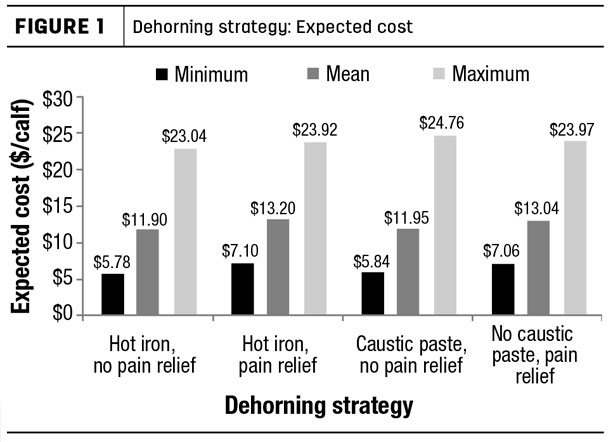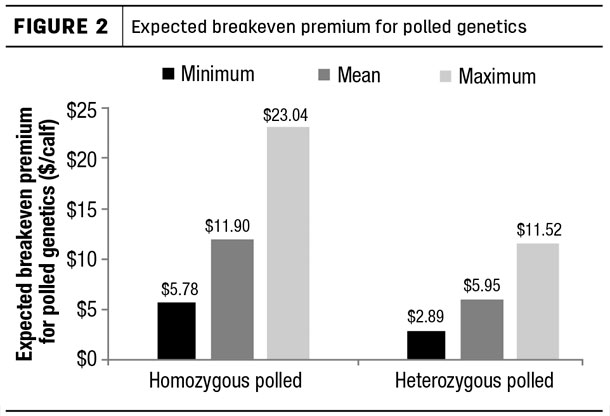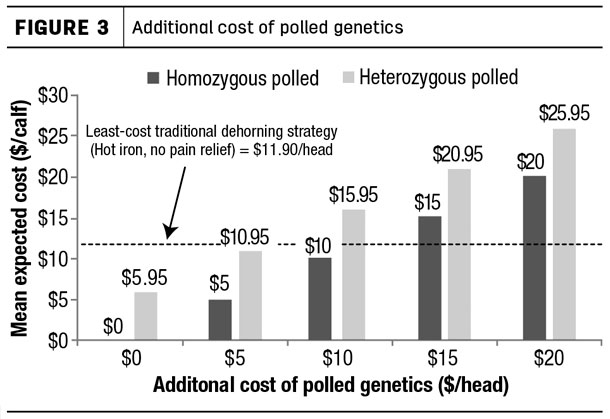Eliminating horns has long been part of basic herd management, but the economic value, practicality and acceptability of traditional horn removal practices is in question. A recent analysis compares the cost of dehorning with breeding for naturally hornless cattle.
According to one study, dehorning is the top welfare concern in dairy production practices in the public eye, alongside tail docking. Currently, the U.S. has no official jurisdiction on disbudding or dehorning in any way unlike several countries, such as Australia, New Zealand and Demark.
In light of the recent tail docking ban in the FARM Program, producers know firsthand that change can be inevitable and requires adaptation in farm practice. There’s no debate among dairymen or the American Veterinary Medical Association (AVMA) that hornless animals work best in production environments. So what might the cost be to alternatively use polled genetics in place of traditional dehorning methods as the mainstay to satisfy public and industry standards?

An article published in the Journal of Dairy Science titled “Economic considerations of breeding for polled dairy cows versus dehorning in the United States” addressed this topic. The study, a collaboration of Nathan Thompson, Nicole Widmar, Michael Schultz, John Cole and Christopher Wolf, found that the mean estimated cost was anywhere from $12 to $13 a head for traditional dehorning methods (Figure 1) and $0 to $26 a head for polled genetics (Figure 2).

It concluded that while polled genetics show promise and economic value for use in breeding programs, there is much reliance on outside factors, including market conditions, cost, availability and genetic merit of polled semen.
Progressive Dairyman spoke with author Nathan Thompson of Purdue University about his thoughts on this hot-button issue.
Why is this such a relevant topic right now?
THOMPSON: Mandating changes in production systems by food retailers or processors has been increasing in recent years in response to social, regulatory and market-based pressures. This has placed increased pressure on a variety of agricultural industries to reevaluate production practices and management techniques. In particular, animal welfare issues have received a lot of attention.
The most relevant to our work is the recent prohibitions on docking tails of dairy cattle in the U.S. In light of this, the risk that consumer acceptance of dehorning will wane is significant.
Explain the dehorning methods evaluated and outcomes of your economic assessment.
THOMPSON: We evaluated six potential dehorning/polled genetics scenarios: hot iron disbudding with no pain relief, hot iron disbudding with pain relief, caustic paste with no pain relief, caustic paste with pain relief, incorporating heterozygous polled genetics and incorporating homozygous polled genetics. Our results indicate that on average hot iron disbudding with no pain relief was the cheapest of the traditional dehorning methods – excluding polled genetics scenarios. This is consistent with what most producers are currently doing. We then estimated how much more producers could pay for polled genetics relative to their current horned genetics and have the same cost of dehorning.
We find that on average producers could pay as much as $6 per head more for heterozygous polled genetics than what they currently pay for horned genetics and $12 per head more for homozygous polled genetics. That’s about $2 per straw of semen more for heterozygous polled genetics and $4 per straw of semen more for homozygous genetics at an assumed conception rate of 35 percent [Figure 3].

What are the key takeaways from your findings for dairy producers?
THOMPSON: Firstly, it may be profitable for some producers to use polled genetics as a way to eliminate horns in their dairy herds. This will obviously depend on the availability, cost and genetic merit of polled semen. The potential for using polled genetics will also vary from farm to farm depending on the cost and efficiency of labor, the chances of needing follow-up treatments and the cost of those treatments.
Secondly, industry-wide discussion may be warranted surrounding the public's acceptance and attitude toward polled genetics versus traditional dehorning methods. If public perception of dehorning influences market access, the cost of dehorning may be much higher than what we estimate. As a result, the producers would be able to pay premiums for polled genetics above the reported values. ![]()
Read the complete study from the Journal of Dairy Science.
Jaclyn Krymowski is a 2017 Progressive Dairyman editorial intern.






